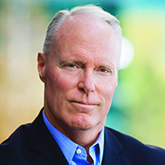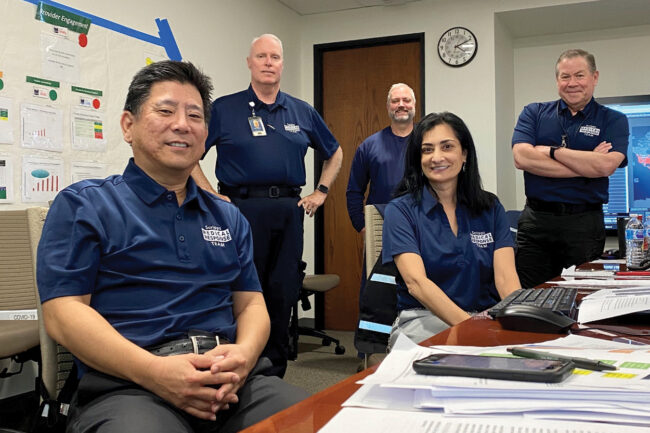“I identified many unsung heroes during both my patient stay & throughout the COVID pandemic, & Supply Chain was definitely one of them.”
—Ghazala Sharieff, M.D., MBA, Chief Medical & Operations Officer, Scripps Health
Lessons learned as a leader & as a patient
Imagine life as a vibrant physician executive in the prime of your career. You have made it a priority to balance long work weeks with family time. To that end, you say “yes” to an invitation for an indoor rock climbing wall outing with your husband and 23- and 25-year-old daughters. Little do you know at the outset, but your life is about to change in a drastic way. The silver lining, however, will forever alter the way you see patients and the care they receive.

Such is the story of Ghazala Sharieff, M.D., MBA, Chief Medical & Operations Officer at HealthTrust member Scripps Health. After losing her grip on the climb, Dr. Sharieff fell and, as a result, became temporarily paralyzed from the neck down.
Luckily, Dr. Sharieff’s story has a happy ending. After just six months, she was able to return to remote work at Scripps Health. However, her journey—from trauma center to ICU to inpatient rehabilitation and then outpatient rehab (which continues today)—opened her eyes to how patients and their families experience the continuum of care on the road from a serious injury to healing and recovery.
She recalls, “When I came out of surgery, my hands were ice cold—so much so that I used up the entire hospital supply of handheld hot packs. Our CEO reached out to Supply Chain, and they were able to secure more of these, even on Christmas Day. Another discovery I had as a patient was my inability to swallow a large acetaminophen tablet. As a result, Scripps added a capsule form of Tylenol to its formulary for other patients who have similar issues.”
“I truly believe that if it weren’t for our Supply Chain professionals who work so diligently behind the scenes, that I would not have had the equipment that was necessary for my emergency and critical surgery. I identified many unsung heroes during both my patient stay and throughout the COVID pandemic, and Supply Chain was definitely one of them,” says Dr. Sharieff.
Leaning into new opportunities
After COVID hit, Dr. Sharieff’s original patient experience and CMO role expanded to include the pandemic command center and then cyberattack response. After Scripps’ CFO retired, she assumed responsibility for Scripps’ Support Services, including Food, Environmental Services, Engineering, Disaster Management and Security.
As if these responsibilities weren’t enough, when one of Scripps’ chief regional executives was on medical leave after a cardiac event, Dr. Sharieff assumed management of three hospitals in Scripps’ northern region. The organization’s CEO then asked her to manage the two hospitals in the southern region, which in turn led to overseeing all five of them. Dr. Sharieff says, “I think if you do something well and for the right reasons, opportunities for growth present themselves.”

In addition to the organization’s regional chief executives, physician operating executives and chiefs of staff, she currently also has responsibility for Support Services, Information Services, Quality and the Employee Assistance Program. After another change in leadership, Supply Chain and Pharmacy also began reporting to her. She recalls it being an easy transition, given the close work she had done with those colleagues during COVID and a cyberattack that impacted Scripps. Dr. Sharieff describes the experience as the “honor of a lifetime to manage areas outside of a CMO’s normal scope.”
Not one to sit on the sidelines, Dr. Sharieff has also been known to roll up her sleeves and work alongside front-line staff when needed. She shares, “In addition to being Scripps’ CEO, my boss, Chris Van Gorder, also happens to be a licensed EMT. At the height of the pandemic, Chris and I were both out there with our clinicians administering COVID vaccines to the thousands of patients who drove through our transitory vaccine ‘clinic.’ ”
Appreciating & empowering colleagues
It was the combination of Dr. Sharieff’s personal patient experience along with the COVID pandemic that revealed to her a newfound respect for the work of a hospital’s Supply Chain team. “Not only was their input critical in keeping track of PPE levels, but when elective surgeries were canceled, it was Supply Chain that helped us determine and prioritize what surgeries our facilities could still offer, by service line, based upon the equipment and supplies we had. We also changed the definition of ‘elective’ and reclassified cases as either critical, urgent, able to be temporarily delayed or truly elective, such as with cosmetic surgeries,” she explains.
When asked how she manages so many different areas of operations, Dr. Sharieff shares, “The people working for you are the key. I am surrounded by a great team of people who keep me informed. I believe in empowering your teams and not micromanaging them. Set the vision so your people see it. If there is an issue, we do sprints to evaluate the options. The team helps to problem-solve; oftentimes they come back with a solution from the front lines.”

Clinical integration
Dr. Sharieff shares that she is passionate about endorsing the importance of executive leadership involvement at the clinical level with the Supply Chain team. “The operational executive physicians within Scripps’ five acute care hospitals have responsibility for value analysis (VA). That work is critical to my role, which includes overseeing value-based purchasing across our entire health system. It’s an offshoot of the VA work,” she says.
Scripps is well positioned to respond to the changing healthcare environment, with Supply Chain helping to inform the organization’s annual capital planning process. This includes physician involvement up front and prioritizing needs for the entire budget year. The regional chief executives, site chief operating executive, physician operating executives, corporate vice president of Support Services, and medical directors are all involved in these discussions. Supply Chain organizes their input into tiers. Those plans are then presented to both Dr. Sharieff and her CMO counterpart in the ambulatory care space. Together, they make decisions based on the recommendations from the Supply Chain and Value Analysis teams. “As a result of my firsthand experience with those teams, I can confidently say that Supply Chain has been integrated with our physicians and clinical initiatives,” says Dr. Sharieff. “We have made this input part of our ongoing process. Now, all of the key stakeholders understand they are part of the systemwide operations meetings we hold every two weeks. Outside of this, if a physician has new technology they want us to consider purchasing, they come before our Medical Elective Review Committee to justify why they need it and speak to the clinical difference the proposed product will make on patient outcomes. This way, our decisions can be made based on evidence and what’s best for our patients,” she adds.
Motivation matters
Dr. Sharieff indicates that she is still in therapy, continuing to work on her balance, walking and issues impacting her hands. “When I was in the hospital, colleagues from Scripps I didn’t even know sent me inspirational cards and signs. I’m not sure what I did to deserve that. My family put the cards and signs up on what we affectionately called the ‘wall of love’ in my patient room. Those messages motivated me to get up every day and keep fighting to get strong and walk again,” she says.
As a leader responsible for the care provided in Scripps’ acute care hospitals, Dr. Sharieff vows to never forget the perspective she gained during the months she spent as a patient. She is also committed to championing initiatives that help the organization uphold its vital, clinically integrated supply chain.
HAVE AN INSPIRING HUMAN INTEREST STORY TO SHARE? We would love to hear from you. Email your story idea for publication consideration to thesource@healthtrustpg.com
Share Email clinical operations, Leadership, Patient advocacy, Q3 2025





